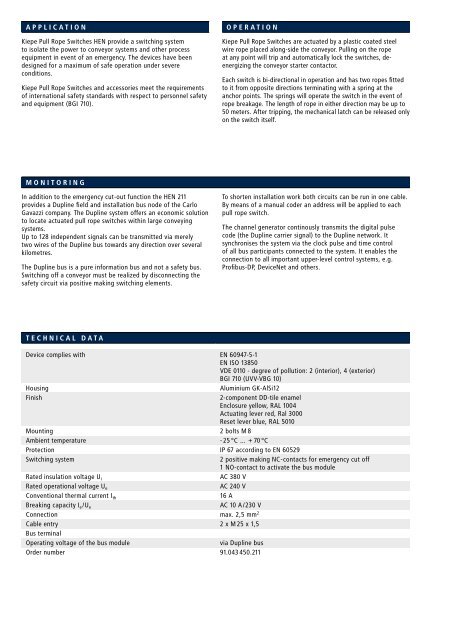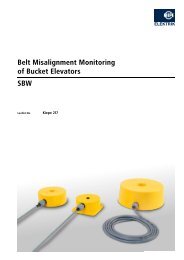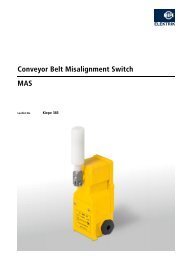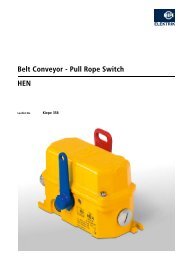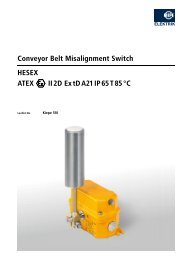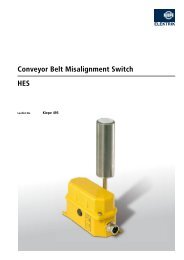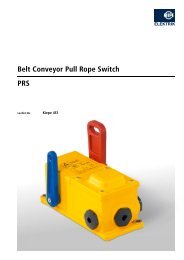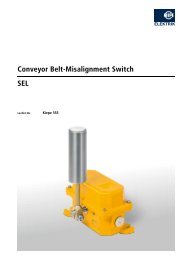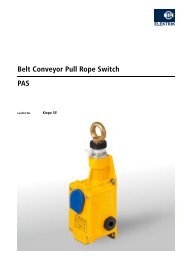Belt Conveyor Pull Rope Switch HEN 211
Belt Conveyor Pull Rope Switch HEN 211
Belt Conveyor Pull Rope Switch HEN 211
You also want an ePaper? Increase the reach of your titles
YUMPU automatically turns print PDFs into web optimized ePapers that Google loves.
application<br />
Kiepe <strong>Pull</strong> <strong>Rope</strong> <strong>Switch</strong>es <strong>HEN</strong> provide a switching system<br />
to isolate the power to conveyor systems and other process<br />
equipment in event of an emergency. The devices have been<br />
designed for a maximum of safe operation under severe<br />
conditions.<br />
Kiepe <strong>Pull</strong> <strong>Rope</strong> <strong>Switch</strong>es and accessories meet the requirements<br />
of international safety standards with respect to personnel safety<br />
and equipment (BGI 710).<br />
operation<br />
Kiepe <strong>Pull</strong> <strong>Rope</strong> <strong>Switch</strong>es are actuated by a plastic coated steel<br />
wire rope placed along-side the conveyor. <strong>Pull</strong>ing on the rope<br />
at any point will trip and automatically lock the switches, deenergizing<br />
the conveyor starter contactor.<br />
Each switch is bi-directional in operation and has two ropes fitted<br />
to it from opposite directions terminating with a spring at the<br />
anchor points. The springs will operate the switch in the event of<br />
rope breakage. The length of rope in either direction may be up to<br />
50 meters. After tripping, the mechanical latch can be released only<br />
on the switch itself.<br />
monitoring<br />
In addition to the emergency cut-out function the <strong>HEN</strong> <strong>211</strong><br />
provides a Dupline field and installation bus node of the Carlo<br />
Gavazzi company. The Dupline system offers an economic solution<br />
to locate actuated pull rope switches within large conveying<br />
systems.<br />
Up to 128 independent signals can be transmitted via merely<br />
two wires of the Dupline bus towards any direction over several<br />
kilometres.<br />
The Dupline bus is a pure information bus and not a safety bus.<br />
<strong>Switch</strong>ing off a conveyor must be realized by disconnecting the<br />
safety circuit via positive making switching elements.<br />
To shorten installation work both circuits can be run in one cable.<br />
By means of a manual coder an address will be applied to each<br />
pull rope switch.<br />
The channel generator continously transmits the digital pulse<br />
code (the Dupline carrier signal) to the Dupline network. It<br />
synchronises the system via the clock pulse and time control<br />
of all bus participants connected to the system. It enables the<br />
connection to all important upper-level control systems, e.g.<br />
Profibus-DP, DeviceNet and others.<br />
technical data<br />
Device complies with EN 60947-5-1<br />
EN ISO 13850<br />
VDE 0110 - degree of pollution: 2 (interior), 4 (exterior)<br />
BGI 710 (UVV-VBG 10)<br />
Housing<br />
Aluminium GK-AlSi12<br />
Finish<br />
2-component DD-tile enamel<br />
Enclosure yellow, RAL 1004<br />
Actuating lever red, Ral 3000<br />
Reset lever blue, RAL 5010<br />
Mounting 2 bolts M 8<br />
Ambient temperature - 25 °C … + 70 °C<br />
Protection IP 67 according to EN 60529<br />
<strong>Switch</strong>ing system<br />
2 positive making NC - contacts for emergency cut off<br />
1 NO-contact to activate the bus module<br />
Rated insulation voltage U i<br />
AC 380 V<br />
Rated operational voltage U e<br />
AC 240 V<br />
Conventional thermal current I th<br />
16 A<br />
Breaking capacity I e / U e<br />
AC 10 A/230 V<br />
Connection max. 2,5 mm 2<br />
Cable entry 2 x M 25 x 1,5<br />
Bus terminal<br />
Operating voltage of the bus module<br />
via Dupline bus<br />
Order number 91.043 450.<strong>211</strong>


